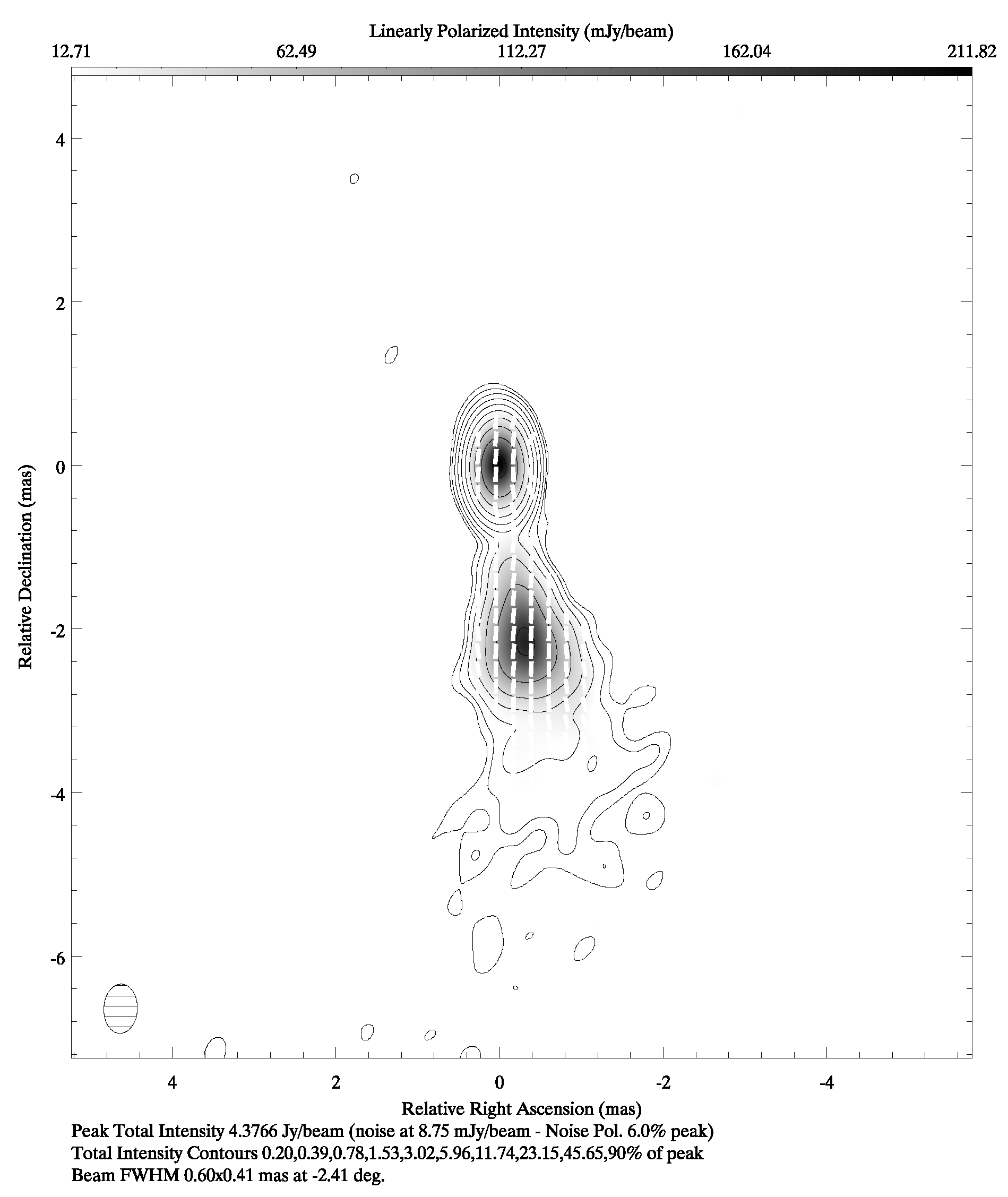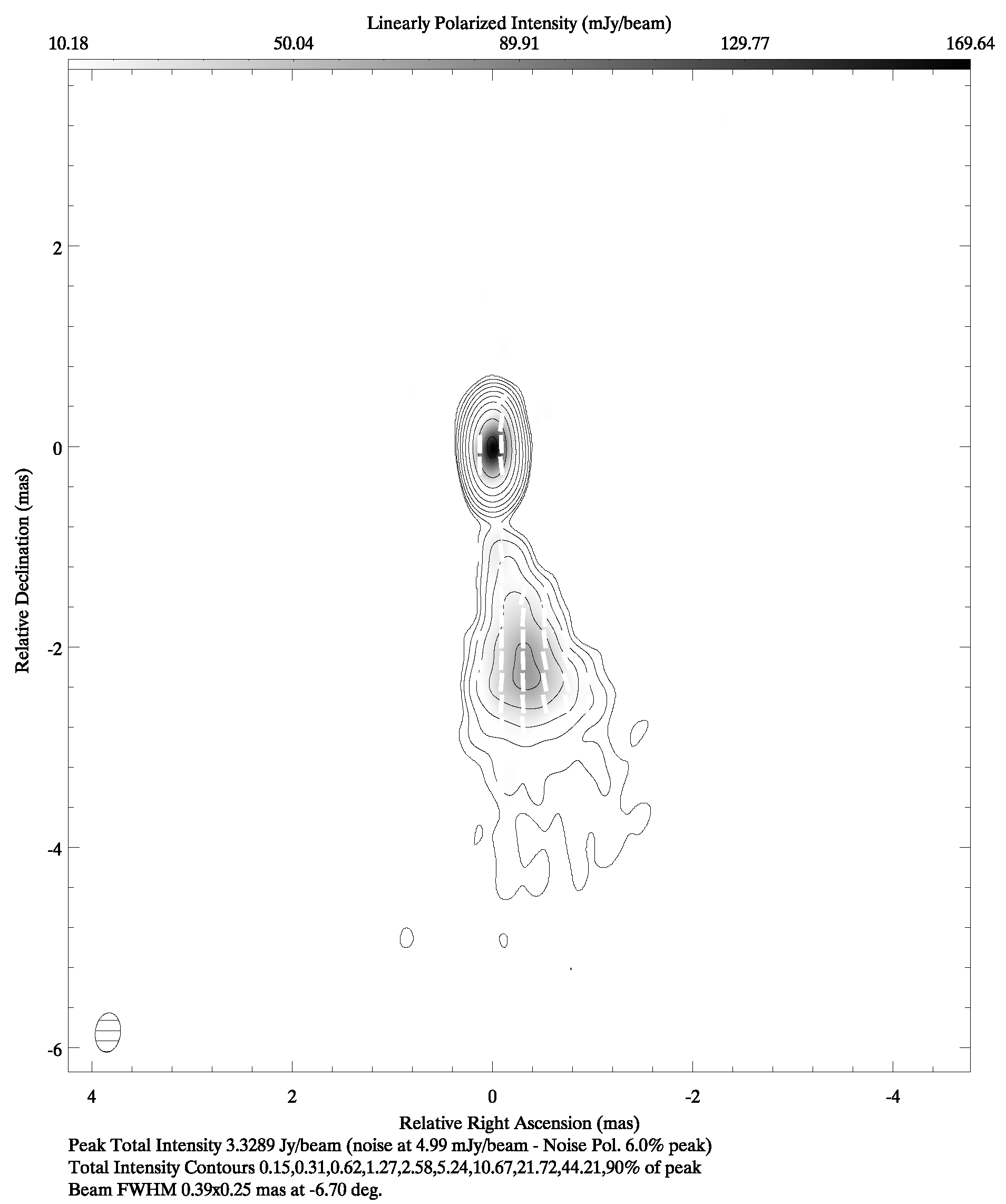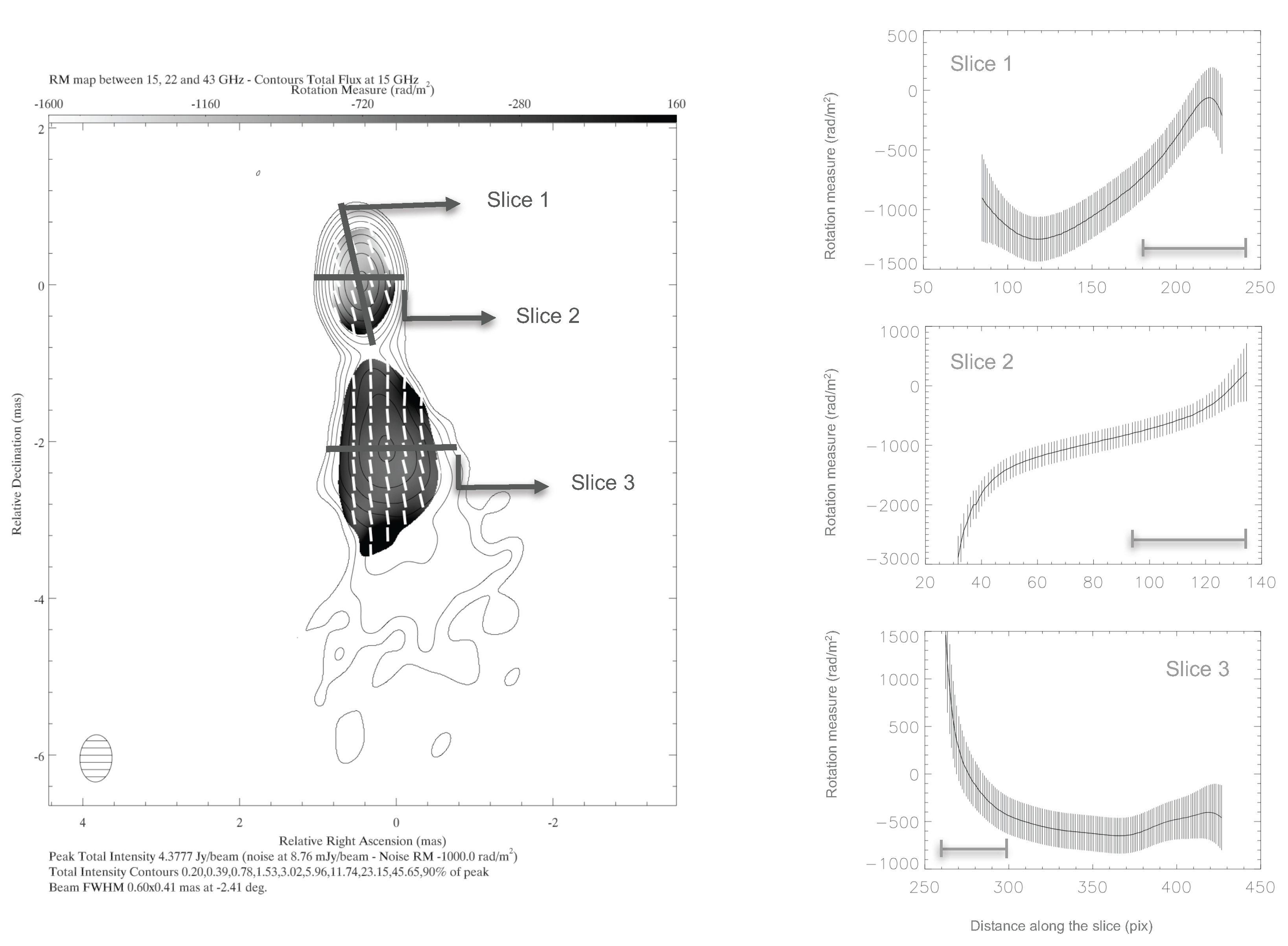1. Introduction
One of the main questions to answer in active galactic nuclei (AGN) jets is the nature of the core, defined as the upstream end of the jet. There are two complementary models. In one of these, the core is the place where the jets becomes optically thin, so the position of the core shifts with observing frequency. This was observed at centimeter wavelength [
1]. On the other hand, there is evidence that most gamma-ray flares are simultaneous with a major outburst in the core of the jet observed at millimeter wavelength. These flares can be explained as a superluminal component going through the mm-core, identified as a recollimation shock [
2,
3,
4,
5]. In this case, the position of the core is fixed at a jet location.
It is broadly accepted that magnetic fields play a relevant role in the dynamics of the innermost regions of relativistic jets. Most of the models propose a helical geometry, although there are still uncertainties regarding the actual configuration.
With the aim of obtaining a better understanding of the structure of the magnetic field and analyzing the nature of the core jet, we have developed a polarized multi-frequency Very Long Baseline Array (VLBA) program in which we have observed a sample of AGN (BL Lacertae, 3C120, 3C273, CTA102, 0716+714, 3C111). In this work, we present the results for BL Lacertae.
2. Observation
Very Long Baseline Interferometry at radio and millimeter frequencies has provided ultra-high-resolution observations which allow us to study the innermost part of AGN jets. The Very Long Baseline Array (VLBA) have receivers in a wide range of frequencies (from 1.2 GHz to 96 GHz), allowing us to perform multifrequency studies in polarization.
We present polarized intensity VLBA images of BL Lacertae at 15, 22, and 43 GHz, obtained in July 2013. These data were taken as a part of an astrometric multifrequency program which includes BL Lacs, flat spectrum radio quasars (FSRQs), and radio galaxies observations with the VLBA. Calibration of the data was performed within the AIPS software following the standard procedure for polarimetric observations. The data were edited, self-calibrated, and imaged both in total and polarized intensity with a combination of the AIPS and Difmap software packages [
6]. Calibration of the electric vector position angle (EVPA) at 15 and 22 GHz was performed by comparison of the integrated polarization measured from the VLBA images and that obtained from MOJAVE team observations [
7] and VLBA-BU-BLAZAR program [
8], respectively, at contemporaneous epochs. With these values, we have calculated the rotation measure (RM) on the southern part of the source (which is an optically thin region and has very low values of RM) and obtained the absolute orientation of the EVPA at 22 GHz.
3. Astrometric Technique
This project was designed to obtain astrometric information from centimeter to millimeter wavelength. Obtaining astrometric measurements at millimeter wavelength is not a simple issue. The technique applied in this work is explained in more detail in [
9]. One method that has worked well for millimeter wavelength is the source/frequency phase referencing (SFPR) [
10], but this technique requires a second calibrator within about
from the target. To overcome this situation, we have developed a new approach to the SFPR, called multi-frequency phase referencing (MFPR), in which we do not need a second calibrator at millimetric wavelength [
9].
We have followed a specific observation strategy consisting of four blocks, in order to calculate the dispersive (i.e., instrumental and ionospheric propagation effects) and non-dispersive residual delay errors (e.g., tropospheric propagation effects and geometric errors) without losing astrometric information [
9]: (1) A usual phase-reference block, observing the target interleaved with a calibrator at 5, 8, 15, and 22 GHz. This block is used to perform the usual phase reference astrometry at centimeter wavelength. (2) An ionospheric block, in which we observe the target (in this case BL Lacertae) at 1.3, 5, and 22 GHz. These observations are used to calculate the ionospheric propagation effects. (3) A frequency-phase-transfer block, observing the target at low frequency (22 GHz) interleave with high frequencies (43 and 86 GHz). This block is necessary to scale the phase corrections at high frequency based on the low frequency ones. (4) A repeat of the ionospheric block. These four steps are cycled around for the duration of the experiment.
In order to eliminate the non-dispersive residual errors, the data at higher frequencies (43 and 86 GHz) are calibrated scaling the phase corrections from near-simultaneous observations at a lower frequency. This is possible as long as the frequency pair (e.g., 22 and 43 GHz) have an integer frequency ratio. After that, it is necessary to calibrate the dispersive residual errors. We have used the corrections of the prime calibrator to remove the instrumental effects in BL Lacertae. The novel part of this technique consists of the way to calculate the ionospheric propagation effects.
This novel technique calculates the total electron content (TEC) in the target direction using a linear fit in to the semi-simultaneous delay measurements. We have calculated this fit for each antenna, intermediate frequency channel (IF), and interval time. This allows us to eliminate the ionospheric contribution from the data.
4. Results
Figure 1,
Figure 2 and
Figure 3 show polarimetric VLBA images of BL Lacertae at 15, 22, and 43 GHz, respectively. The structure of BL Lacertae is dominated by the nuclear region plus an extended and bright structure towards the south. The electric vector position angle (EVPA) along the southern jet, and also along the nuclear region, are mainly aligned with the jet direction. This behavior is consistent with the presence of a helical magnetic field geometry, where the toroidal component is dominant over the poloidal one all along the pc-scale jet [
11]. This behavior is consistent with previous results presented in [
12].
The rotation measure (RM) depends on the electron density and the component of the magnetic field in the direction of the line-of-sight. For this reason, RM maps give relevant information about the magnetic structure in the radio source or in the immediate vicinity.
Figure 4 shows the rotation measure map of BL Lacertae obtained by combining the 15, 22, and 43 GHz data, superposed with contours representing the total intensity at 15 GHz. BL Lacertae are also affected by a small Faraday rotation contribution from our own galaxy, which has been accounted for using the values in [
13]. We have estimated the errors in the RM as the uncertainty in the chi-square fit to the
dependence of the EVPAs. The EVPA errors for each observing frequency are calculated from error propagation of the uncertainties in Q and U, added in quadrature to the error in the calibration of the absolute orientation.
The values of RM increase towards the nuclear regions, as we can see in slice 1 along the jet core. This result is in agreement with previous studies of BL Lacertae (e.g., [
12]), and could be produced by a higher electron density in the internal regions.
By inspecting slices 2 and 3 in
Figure 4, we note a gradient of RM across the jet width, as it was observed in a number of sources [
12,
14,
15,
16].
According to [
15], a minimum resolution of two observing beams is required for a reliable determination of RM gradients in jet profiles. Our achieved resolution is just above two observing beams for the slices in the core area (slices 1 and 2), and larger for slice 3 in the jet, confirming the reliability of the measured RM gradients.
The gradient across the jet width could be a signature of a helical magnetic field in which the toroidal component dominates over the poloidal one. The results presented in this work are in agreement with the structure of the RM presented by [
17], in which the RM shows a gradient with position angle from the centroid of the core with positive RM values in the area upstream of the centroid and negative downstream. This change in the sign of the RM supports the model of the helical magnetic field and has also been observed in a few other sources [
15,
17].
The astrometry results are presented in more detail in [
9]. The absolute position of the core between cm-mm wavelengths departs from the expected in case the core is located at the optically thin–thick transition. That is, the core shift between 22 and 43 GHz is smaller than the prediction from measurements of the core shift at cm wavelengths. This supports the model on which the mm-VLBI core corresponds to a recollimation shock.
Acknowledgments
This research has been supported by the Spanish Ministry of Economy and Competitiveness grant AYA2016-80889-P. The VLBA is an instrument of the National Radio Astronomy Observatory, a facility of the National Science Foundation operated under cooperative agreement by Associated Universities.
Author Contributions
J.L.G., R.D. and M.J.R. designed the experiment and the observations. S.N.M. analyzed the data, made the plots, and wrote the paper. R.D. and M.J.R. contributed to the analysis of the data and J.L.G. contributed in the writing and interpretation of the results.
Conflicts of Interest
The authors declare no conflict of interest.
References
- Hada, K.; Doi, A.; Kino, M.; Nagai, H.; Hagiwara, Y.; Kawaguchi, N. An origin of the radio jet in M87 at the location of the central black hole. Nature 2011, 477, 185–187. [Google Scholar] [CrossRef] [PubMed]
- Marscher, A.P.; Jorstad, S.G.; D’Arcangelo, F.D.; Smith, P.S.; Williams, G.G.; Larionov, V.M.; Oh, H.; Olmstead, A.R.; Aller, M.F.; Aller, H.D.; et al. The inner jet of an active galactic nucleus as revealed by a radio-to-gamma-ray outburst. Nature 2008, 452, 966–969. [Google Scholar] [CrossRef] [PubMed]
- Marscher, A.P.; Jorstad, S.G.; Larionov, V.M.; Aller, M.F.; Aller, H.D.; Lähteenmäki, A.; Agudo, I.; Smith, P.S.; Gurwell, M.; Hagen-Thorn, V.A. Probing the inner jet of the quasar PKS 1510–089 with multi-waveband monitoring during strong gamma-ray activity. Astrophys. J. Lett. 2010, 710, L126. [Google Scholar] [CrossRef]
- Jorstad, S.G.; Marscher, A.P.; Smith, P.S.; Larionov, V.M.; Agudo, I.; Gurwell, M.; Wehrle, A.E.; Lähteenmäki, A.; Nikolashvili, M.G.; Schmidt, G.D.; et al. A tight connection between gamma-ray outbursts and parsec-scale jet activity in the quasar 3c 454.3. Astrophys. J. 2013, 773, 147. [Google Scholar] [CrossRef]
- Casadio, C.; Gómez, J.L.; Jorstad, S.G.; Marscher, A.P.; Larionov, V.M.; Smith, P.S.; Gurwell, M.A.; Lähteenmäki, A.; Agudo, I.; Molina, S.N.; et al. A multi-wavelength polarimetric study of the blazar CTA 102 during a gamma-ray flare in 2012. Astrophys. J. 2015, 813, 51. [Google Scholar] [CrossRef]
- Shepherd, M.C. Difmap: An Interactive Program for Synthesis Imaging. ASP Conf. Ser. 1997, 125, 77. [Google Scholar]
- Lister, M.L.; Cohen, M.H.; Homan, D.C.; Kadler, M.; Kellermann, K.I.; Kovalev, Y.Y.; Ros, E.; Savolainen, T.; Zensus, J.A. MOJAVE: Monitoring of jets in active galactic nuclei with VLBA experiments. VI. Kinematics analysis of a complete sample of blazar jets. Astron. J. 2009, 138, 1874–1892. [Google Scholar] [CrossRef]
- Jorstad, S.; Marscher, A. The VLBA-BU-BLAZAR Multi-Wavelength Monitoring Program. Galaxies 2016, 4, 47. [Google Scholar] [CrossRef]
- Dodson, R.; Rioja1, M.J.; Molina, S.N.; Gómez, J.L. High-precision astrometric millimeter very long baseline interferometry using a new method for multi-frequency calibration. Astrophys. J. 2017, 834, 10. [Google Scholar] [CrossRef]
- Rioja, M.J.; Dodson, R. High-precision astrometric millimeter very long baseline interferometry using a new method for atmospheric calibration. Astron. J. 2011, 141, 15. [Google Scholar] [CrossRef]
- Lyutikov, M.; Pariev, V.I.; Gabuzda, D.C. Polarization and structure of relativistic parsec-scale AGN jets. Mon. Not. Roy. Astron. Soc. 2005, 360, 869–891. [Google Scholar] [CrossRef]
- O’Sullivan, S.P.; Gabuzda, D.C. Three-dimensional magnetic field structure of six parsec-scale active galactic nuclei jets. Mon. Not. Roy. Astron. Soc. 2009, 393, 429–456. [Google Scholar] [CrossRef]
- Taylor, A.R.; Stil, J.M.; Sunstrum, C. A rotation measure image of the sky. Astrophys. J. 2009, 702, 1230–1236. [Google Scholar] [CrossRef]
- Asada, K.; Inoue, M.; Uchida, Y.; Kameno, S.; Fujisawa, K.; Iguchi, S.; Mutoh, M. A Helical Magnetic Field in the Jet of 3C 273. Publ. Astron. Soc. Jpn. 2002, 54, L39. [Google Scholar] [CrossRef]
- Hovatta, T.; Lister, M.L.; Aller, M.F.; Aller, H.D.; Homan, D.C.; Kovalev, Y.Y.; Pushkarev, A.B.; Savolainen, T. MOJAVE: Monitoring of Jets in Active Galactic Nuclei with VLBA Experiments. VIII. Faraday Rotation in Parsec-scale AGN Jets. Astron. J. 2012, 144, 105. [Google Scholar] [CrossRef]
- Gómez, J.L.; Marscher, A.P.; Jorstad, S.G.; Agudo, I.; Roca-Sogorb, M. Faraday rotation and polarization gradients in the jet of 3C 120: Interaction with the external medium and a helical magnetic field? Astrophys. J. 2008, 681, L69. [Google Scholar] [CrossRef]
- Gómez, J.L.; Lobanov, A.P.; Bruni, G.; Kovalev, Y.Y.; Marscher, A.P.; Jorstad, S.G.; Mizuno, Y.; Bach, U.; Sokolovsky, K.V.; Anderson, J.M. Probing the innermost regions of agn jets and their magnetic fields with Radioastron. I. Imaging BL Lacertae at 21 μ as resolution. Astrophys. J. 2016, 817, 14. [Google Scholar] [CrossRef]
© 2017 by the authors. Licensee MDPI, Basel, Switzerland. This article is an open access article distributed under the terms and conditions of the Creative Commons Attribution (CC BY) license (http://creativecommons.org/licenses/by/4.0/).









